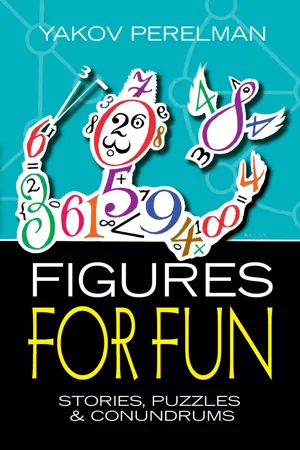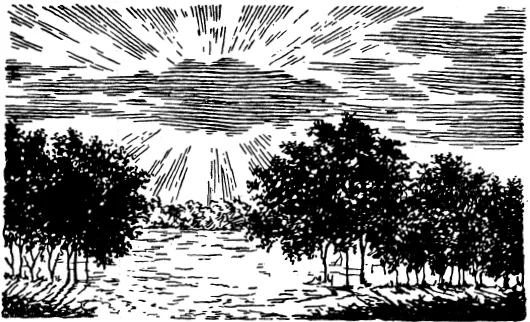![]()
CHAPTER I
BRAIN-TEASERS FOR LUNCH
It was raining. . . . We had just sat down for lunch at our holiday home when one of the guests asked us whether we would like to hear what had happened to him in the morning.
Everyone assented, and he began.
1. A SQUIRREL IN THE GLADE.— “I had quite a bit of fun playing hide-and-seek with a squirrel,” he said. “You know that little round glade with a lone birch in the centre? It was on this tree that a squirrel was hiding from me. As I emerged from a thicket, I saw its snout and two bright little eyes peeping from behind the trunk. I wanted to see the little animal, so I started circling round along the edge of the glade, mindful of keeping the distance in order not to scare it. I did four rounds, but the little cheat kept backing away from me, eyeing me suspiciously from behind the tree. Try as I did, I just could not see its back.”
“But you have just said yourself that you circled round the tree four times,” one of the listeners interjected.
“Round the tree, yes, but not round the squirrel.”
“But the squirrel was on the tree, wasn’t it?”
“So it was.”
“Well, that means you circled round the squirrel too.”
“Call that circling round the squirrel when I didn’t see its back?”
“What has its back to do with the whole thing? The squirrel was on the tree in the centre of the glade and you circled round the tree. In other words, you circled round the squirrel.”
“Oh no, I didn’t. Let us assume that I’m circling round you and you keep turning, showing me just your face. Gall that circling round you?”
“Of course, what else can you call it?”
“You mean I’m circling round you though I’m never behind you and never see your back?”
“Forget the back! You’re circling round me and that’s what counts. What has the back to do with it?”
“Wait. Tell me, what’s circling round anything? The way I understand it, it’s moving in such a manner so as to see the object I’m moving around from all sides. Am I right, professor?” He turned to an old man at our table.
“Your whole argument is essentially one about a word,” the professor replied. “What you should do first is agree on the definition of ‘circling.’ How do you understand the words ‘circle round an object’? There are two ways of understanding that. Firstly, it’s moving round an object that is in the centre of a circle. Secondly, it’s moving round an object in such a way as to see all its sides. If you insist on the first meaning, then you walked round the squirrel four times. If it’s the second that you hold to, then you did not walk round it at all. There’s really no ground for an argument here, that is, if you two speak the same language and understand words in the same way.”
“All right, I grant there are two meanings. But which is the correct one?”
“That’s not the way to put the question. You can agree about anything. The question is, which of the two meanings is the more generally accepted? In my opinion, it’s the first and here’s why. The sun, as you know, does a complete circuit in 26 days. . . .”
“Does the sun revolve?”
“Of course, it does, like the earth. Just imagine, for instance, that it would take not 26 days, but 365¼ days, i.e., a whole year, to do so. If this were the case, the earth would see only one side of the sun, that is, only its ‘face.’ And yet, can anyone claim that the earth does not revolve round the sun?”
“Yes, now it’s clear that I circled round the squirrel after all.”
“I’ve a suggestion, comrades!” one of the company shouted. “It’s raining now, no one is going out, so let’s play riddles. The squirrel riddle was a good beginning. Let each think of some brain-teaser. “
“I give up if they have anything to do with algebra or geometry,” a young woman said.
“Me too,” another joined in.
“No, we must all play; but we’ll promise to refrain from any algebraical or geometrical formulas, except, perhaps, the most elementary ones. Any objections?”
“None!” the others chorussed. “Let’s go.”
“One more thing. Let professor be our judge.”
2. SCHOOL-GROUPS.— “We have five extra-curricular groups at school,” a Young Pioneer began. “They’re political, literary, photographic, chess and choral groups. The political group meets every other day, the literary every third day, the photographic every fourth day, the chess every fifth day and the choral every sixth day. These five groups first met on January 1 and thenceforth meetings were held according to schedule. The question is, how many times did all the five meet on the one and same day in the first quarter (January 1 excluded)?”
“Was it a Leap Year?”
“No.”
“In other words, there were 90 days in the first quarter.”
“Right.”
“Let me add another question,” the professor broke in. “It’s this: how many days were there when none of the groups met in that first quarter?”
“So, there’s a catch to it? There’ll be no other evening when all the five groups meet and no evening when some do not meet. That’s clear!”
“Why?”
“Don’t know. But I’ve a feeling there’s a catch.”
“Comrades!” said the man who had suggested the game. “We won’t reveal the results now. Let’s have more time to think about them. Professor will announce the answers at supper.”
3. WHO COUNTED MORE?– “Two persons, one standing at the door of his house and the other walking up and down the pavement, were counting passers-by for a whole hour. Who counted more?”
“Naturally the one walking up and down,” said somebody at the end of the table.
“We’ll know the answer at supper,” the professor said. “Next!”
4. GRANDFATHER AND GRANDSON.— “In 1932 I was as old as the last two digits of my birth year. When I mentioned this interesting coincidence to my grandfather, he surprised me by saying that the same applied to him too. I thought that impossible. ...”
“Of course that’s impossible,” a young woman said.
“Believe me, it’s quite possible and grandfather proved it too. How old was each of us in 1932 ?”
5. RAILWAY TICKETS. — “I’m a railway ticket seller,” said the next person, a young lady. “People think this job is easy. They probably have no idea how many tickets one has to sell, even at a small station. There are 25 stations on my line and different tickets for each section up and down the line. How many different kinds of tickets do you think I have at my station?”
“Your turn next,” the professor said to a flier.
6. A DIRIGIBLE’S FLIGHT.— “A dirigible took off from Leningrad in a northerly direction. Five hundred kilometres away it turned and flew 500 kilometres eastward. After that it turned south and covered another 500 kilometres. Then it flew 500 kilometres in a westerly direction, and landed. The question is, where did it land: west, east, north or south of Leningrad?”
“That’s an easy one,” someone said. “Five hundred steps forward, 500 to the right, 500 back and 500 to the left, and you’re naturally back where you’d started from!”
“Easy? Well then, where did the dirigible land?”
“In Leningrad, of course. Where else?”
“Wrong!”
“Then I don’t understand.”
“Yes, there’s some catch to this puzzle,” another joined in. “Didn’t the dirigible land in Leningrad?”
“Won’t you repeat your problem?”
The flier did. The listeners looked at each other.
“All right,” the professor said. “We have enough time to think about the answer. Let’s have the next one now.”
7. SHADOW. — “My puzzle,” said the next man, “is also about a dirigible. What’s longer, the dirigible or its perfect shadow?”
“Is that all?”
Fig. 1. Sunrays spread from behind a cloud.
“It is.”
“Well, then. The shadow is naturally longer than the dirigible: sun-rays spread fanlike, don’t they?”
“I wouldn’t say so,” another interjected. “Sunrays are parallel to each other and that being so, the dirigible and its shadow are of the same size.”
“No, they aren’t. Have you ever seen rays spreading from behind a cloud? If you have, you’ve probably noticed how much they spread. The shadow of the dirigible must be considerably bigger than the dirigible itself, just as the shadow of a cloud is bigger than the cloud itself.”
“Then why is it that people say that sunrays are parallel to each other? Seamen, astronomers, for instance.”
The professor put a stop to the argument by asking the next person to go ahead with his conundrum.
8. MATCHES. —The man emptied a box of matches on the table and divided the...

